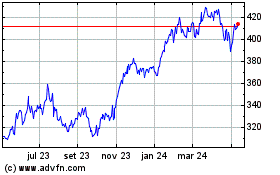U.S. Stocks May Move Back To The Upside In Early Trading
26 Março 2024 - 10:09AM
IH Market News
The major U.S. index futures are currently pointing to a higher
open on Tuesday, with stocks likely to move back to the upside
following the modest weakness seen on Monday.
Optimism about the outlook for interest rates may inspire
renewed buying interest on Wall Street following the Federal
Reserve’s monetary policy announcement last week.
While the Fed left interest rates unchanged, as widely expected,
officials maintained their forecast for three rate cuts this
year.
Following the Fed announcement, the chances of a 25 basis point
rate cut in June have rebounded to 64.4 percent, according to CME
Group’s FedWatch Tool.
The major averages rallied to record highs on the heels of the
Fed announcement last week, leading to some profit taking over the
past two sessions.
Selling pressure remained subdued, however, as traders seem more
concerned about missing out on further upside than suggestions the
markets are overbought.
After an early move to the downside, stocks fluctuated over the
course of the trading session on Monday but largely maintained a
negative bias. The major averages all finished the day lower after
ending last Friday’s trading mixed.
The tech-heavy Nasdaq fell 44.35 points or 0.3 percent to
16,384.47, pulling back off the record closing high set in the
previous session, while the S&P 500 dipped 15.99 points or 0.3
percent to 5,218.19 and the Dow slid 162.26 points or 0.4 percent
to 39,313.64.
Weakness among technology stocks weighed on the markets early in
the session, with semiconductor giant Intel (NASDAQ:INTC) plunging
by as much as 4.7 percent to its lowest intraday level in over four
months.
The steep drop came after a report from the Financial Times said
China has introduced new guidelines to phase microprocessors from
Intel and Advanced Micro Devices (NASDAQ:AMD) out of government PCs
and servers.
Intel climbed well off its worst levels but still slumped by 1.7
percent, while AMD ended the day down by 0.6 percent.
Shares of Microsoft (NASDAQ:MSFT) also fell by 1.4 percent after
the FT said stricter Chinese government procurement guidance also
seeks to sideline the company’s Windows operating system and
foreign-made database software in favor of domestic options.
Nonetheless, selling pressure remained relatively subdued, as
traders seemed reluctant to make more significant moves ahead of
the release of some key economic data in the coming days.
Traders are likely to keep an eye on reports on durable goods
orders, consumer confidence and pending home sales, although a
report on personal income and spending that includes readings on
inflation said to be preferred by the Fed will be released when the
markets are closed for Good Friday.
The Commerce Department released a report this morning showing
new home sales in the U.S. unexpectedly decreased in the month of
February.
The report said new home sales dipped by 0.3 percent to an
annual rate of 662,000 in February after jumping by 1.7 percent to
a revised rate of 664,000 in January.
Economists had expected new home sales to surge by 2.9 percent
to a rate of 680,000 from the 661,000 originally reported for the
previous month.
Despite the modest weakness shown by the broader markets,
airline stocks showed a strong move to the upside on the day, with
the NYSE Arca Airline Index climbing by 1.5 percent.
Oil service stocks also saw considerable strength amid a sharp
increase by the price of crude oil, driving the Philadelphia Oil
Service Index up by 1.2 percent to a five-month closing high.
Computer hardware and oil producer stocks also saw some strength
on the day, while software stocks moved to the downside.
Microsoft (NASDAQ:MSFT)
Gráfico Histórico do Ativo
De Mar 2024 até Abr 2024

Microsoft (NASDAQ:MSFT)
Gráfico Histórico do Ativo
De Abr 2023 até Abr 2024
